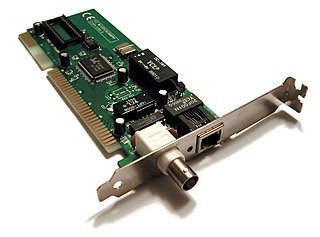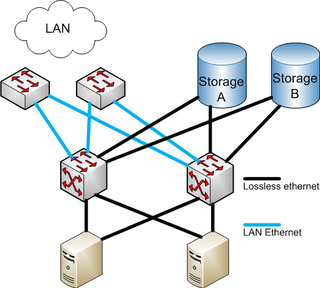Related Research Articles
A network operating system (NOS) is a specialized operating system for a network device such as a router, switch or firewall.

A terminal emulator, or terminal application, is a computer program that emulates a video terminal within some other display architecture. Though typically synonymous with a shell or text terminal, the term terminal covers all remote terminals, including graphical interfaces. A terminal emulator inside a graphical user interface is often called a terminal window.

A network interface controller is a computer hardware component that connects a computer to a computer network.
OpenVPN is a virtual private network (VPN) system that implements techniques to create secure point-to-point or site-to-site connections in routed or bridged configurations and remote access facilities. It implements both client and server applications.

NetworkManager is a daemon that sits on top of libudev and other Linux kernel interfaces and provides a high-level interface for the configuration of the network interfaces.

VMware ESXi is an enterprise-class, type-1 hypervisor developed by VMware, a subsidiary of Broadcom, for deploying and serving virtual computers. As a type-1 hypervisor, ESXi is not a software application that is installed on an operating system (OS); instead, it includes and integrates vital OS components, such as a kernel.
The current portfolio of PowerConnect switches are now being offered as part of the Dell Networking brand: information on this page is an overview of all current and past PowerConnect switches as per August 2013, but any updates on current portfolio will be detailed on the Dell Networking page.
A home server is a computing server located in a private computing residence providing services to other devices inside or outside the household through a home network or the Internet. Such services may include file and printer serving, media center serving, home automation control, web serving, web caching, file sharing and synchronization, video surveillance and digital video recorder, calendar and contact sharing and synchronization, account authentication, and backup services. In the recent times, it has become very common to run hundreds of applications as containers, isolated from the host operating system.
Dell Force10, was a United States company that developed and marketed 10 Gigabit and 40 Gigabit Ethernet switches for computer networking to corporate, educational, and governmental customers. It had offices in North America, Europe, and the Asia Pacific region.
NX-OS is a network operating system for the Nexus-series Ethernet switches and MDS-series Fibre Channel storage area network switches made by Cisco Systems. It evolved from the Cisco operating system SAN-OS, originally developed for its MDS switches.

Fibre Channel over Ethernet (FCoE) is a computer network technology that encapsulates Fibre Channel frames over Ethernet networks. This allows Fibre Channel to use 10 Gigabit Ethernet networks while preserving the Fibre Channel protocol. The specification was part of the International Committee for Information Technology Standards T11 FC-BB-5 standard published in 2009. FCoE did not see widespread adoption.
The Cisco Nexus series switches are modular and fixed port network switches designed for the data center. Cisco Systems introduced the Nexus Series of switches on January 28, 2008. The first chassis in the Nexus 7000 family is a 10-slot chassis with two supervisor engine slots and eight I/O module slots at the front, as well as five crossbar switch fabric modules at the rear. Beside the Nexus 7000 there are also other models in the Nexus range.

Junos OS is a FreeBSD-based network operating system used in Juniper Networks routing, switching and security devices.

The Dell blade server products are built around their M1000e enclosure that can hold their server blades, an embedded EqualLogic iSCSI storage area network and I/O modules including Ethernet, Fibre Channel and InfiniBand switches.
FTOS or Force10 Operating System is the firmware family used on Force10 Ethernet switches. It has a similar functionality as Cisco's NX-OS or Juniper's Junos. FTOS 10 is running on Debian. As part of a re-branding strategy of Dell FTOS will be renamed to Dell Networking Operating System (DNOS) 9.x or above, while the legacy PowerConnect switches will use DNOS 6.x: see the separate article on DNOS.
Virtual Link Trunking (VLT) is a name that has been used for at least two proprietary network protocols. A link aggregation protocol developed by Force10 and an early VLAN tagging capability from 3Com.
Dell Networking is the name for the networking portfolio of Dell. In the first half of 2013, Dell started to rebrand their different existing networking product brands to Dell Networking. Dell Networking is the name for the networking equipment that was known as Dell PowerConnect, as well as the Force10 portfolio.

SoftEther VPN is free open-source, cross-platform, multi-protocol VPN client and VPN server software, developed as part of Daiyuu Nobori's master's thesis research at the University of Tsukuba. VPN protocols such as SSL VPN, L2TP/IPsec, OpenVPN, and Microsoft Secure Socket Tunneling Protocol are provided in a single VPN server. It was released using the GPLv2 license on January 4, 2014. The license was switched to Apache License 2.0 on January 21, 2019.
Enterprise Storage OS, also known as ESOS, is a Linux distribution that serves as a block-level storage server in a storage area network (SAN). ESOS is composed of open-source software projects that are required for a Linux distribution and several proprietary build and install time options. The SCST project is the core component of ESOS; it provides the back-end storage functionality.
References
- ↑ Architecture description of the Force10 E-series platform. Force10, 2006. Retrieved: 3 August 2012
- ↑ Force10 FTOS Datasheet [ permanent dead link ], retrieved: 28 January 2012
- ↑ Communication Security Establishment Canada (CSEC) on Force10 FTOS 7.8 Archived 2011-08-19 at the Wayback Machine
- ↑ CSEC report on Security Target: Force10 Networks FTOS 7.8 Archived 2013-06-04 at the Wayback Machine , published: 17 August 2009, retrieved: 28 January 2012
- ↑ Dell Force10 Open Automation 2.0 [ permanent dead link ], visited 29 May 2013
- ↑ Humair Ahmed offering DNOS9 scripts to others. Checked 10 May 2013
- ↑ Networkcomputing.com: F10 enhances open automation framework with.... [ permanent dead link ], 9 November 2010. Visited: 29 May 2013
- 1 2 Technical Whitepaper: Network automation with F10 Open Automation Framework, downloaded 25 May 2013
- ↑ Dell technical specsheet: Open Automation Framework Archived 2013-03-19 at the Wayback Machine , downloaded: 29 May 2013
- ↑ IT Online: Dell decouples hardware and software, 7 February 2014. visited: 28 April 2014